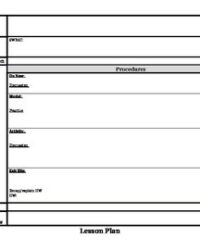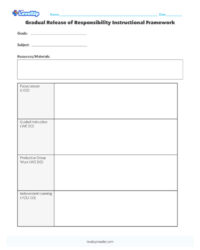Teaching can often feel like a juggling act, trying to ensure every student grasps new concepts while also fostering their independence. It’s a delicate balance, isn’t it? That’s where the gradual release of responsibility framework comes into its own, providing a clear, structured pathway for learning. It’s a method that moves students from complete reliance on the teacher to confident, independent application of skills and knowledge.
This approach isn’t just about showing students what to do; it’s about guiding them through the process, step by step, until they can do it on their own. And to make this process smoother and more consistent, having a reliable gradual release of responsibility lesson plan template can be an absolute game-changer. It ensures you hit all the necessary points, providing a seamless transfer of knowledge and skill.
Understanding the Core Principles of Gradual Release
At its heart, the gradual release of responsibility model, often referred to as “I Do, We Do, You Do,” is a powerful instructional strategy designed to scaffold learning. It systematically transfers the ownership of learning from the teacher to the student. Imagine building a bridge: initially, the architect (teacher) does most of the work, then collaborates with the team (students), and finally, the team can build similar structures independently. This structured progression helps students internalize new skills and concepts deeply.
This method isn’t just about rote memorization; it’s about developing genuine understanding and the ability to apply what’s learned in new contexts. By progressively handing over control, students build confidence, develop critical thinking skills, and become more self-reliant learners. It empowers them to take charge of their own educational journey, moving beyond just passive reception of information.
The teacher’s role evolves significantly through the stages of gradual release. Initially, you are the expert, the model, the clear communicator. As students gain confidence, your role shifts to that of a facilitator, a guide, and a strategic questioner. You provide just enough support to ensure success without doing the work for them, a concept known as “scaffolding.” This nuanced support is key to preventing frustration while promoting growth.
Furthermore, the gradual release model is incredibly adaptable and inclusive. It allows for differentiation, meaning you can tailor your support to meet the diverse needs of all learners in your classroom. Some students might need extended time in the “We Do” phase, while others might quickly move to “You Do (Together)” or “You Do (Alone).” This flexibility ensures that every student, regardless of their starting point, can experience success.
The “I Do” Stage: Focused Instruction
This is where you, the teacher, explicitly model the skill or concept. You think aloud, demonstrate the process, and clearly articulate your reasoning. It’s about showing students exactly what they are expected to learn and how to approach it. Think of it as a master chef demonstrating a complex recipe from start to finish.
The “We Do” Stage: Guided Instruction
In this phase, you and your students work together. You might ask guiding questions, prompt their thinking, or provide immediate feedback as they attempt the skill with your direct support. It’s a collaborative effort where mistakes are opportunities for learning, and students feel safe to try things out with a safety net.
The You Do (Together) Stage: Collaborative Practice
Often, after “We Do,” students benefit from working with peers. This stage involves students working in pairs or small groups, applying the new skill with some supervision but increasing independence. They can discuss, share ideas, and problem-solve together, reinforcing their understanding before independent application.
The You Do (Alone) Stage: Independent Practice
Finally, students are ready to apply the skill or concept entirely on their own. This is where they demonstrate their mastery. It might involve independent assignments, projects, or assessments. This stage confirms their understanding and ability to perform the task without direct assistance.
Crafting Your Own Gradual Release of Responsibility Lesson Plan Template
Moving from understanding the theory to putting it into practice becomes much easier when you have a solid framework. A gradual release of responsibility lesson plan template acts as your blueprint, ensuring you consistently implement all four stages effectively. It helps you pre-plan not just what you’ll teach, but how you’ll progressively empower your students to master it.
The beauty of a template lies in its adaptability. While it provides a structured guide, it’s not rigid. You can customize your gradual release of responsibility lesson plan template to suit different subjects, grade levels, and specific learning objectives. Whether you’re teaching math, literacy, science, or a creative art, the underlying principles remain the same, allowing you to tailor the content to fit your unique classroom needs.
Using a template also brings efficiency to your lesson planning. Instead of starting from scratch every time, you have a clear outline that reminds you to include specific activities for each stage of release. This consistency in planning translates into clearer expectations for students and a more organized learning environment overall, saving you valuable time and mental energy.
Here are some essential components to include in your template:
- Learning Objective(s): What students will know or be able to do by the end of the lesson.
- Materials Needed: All resources required for teacher modeling, group work, and independent practice.
- “I Do” (Focused Instruction) Activities: Detailed steps for how you will model the concept or skill, including your think-alouds.
- “We Do” (Guided Instruction) Activities: Collaborative tasks, specific questions to ask, and how you will provide support and feedback.
- “You Do Together” (Collaborative Practice) Activities: Strategies for peer work, group discussions, or partner activities.
- “You Do Alone” (Independent Practice) Activities: Assignments or tasks students will complete on their own to demonstrate mastery.
- Differentiation Strategies: How you will support struggling learners and extend the learning for advanced students at each stage.
- Assessment: How you will check for understanding at various points throughout the lesson.
Embracing the gradual release of responsibility model transforms teaching from a delivery system into a dynamic journey of shared learning and eventual independence. By systematically transferring ownership of learning, you’re not just imparting knowledge; you’re cultivating critical thinkers and confident problem-solvers. A well-designed gradual release of responsibility lesson plan template is more than just a document; it’s a strategic partner in this transformative process.
Ultimately, equipping students with the tools to learn independently is one of the greatest gifts we can give them. Implementing this framework, guided by a clear and comprehensive template, allows you to consistently build those essential skills. It fosters a classroom where students are actively engaged, feel supported in their growth, and are empowered to take command of their own learning, setting them up for success far beyond the confines of your classroom.


